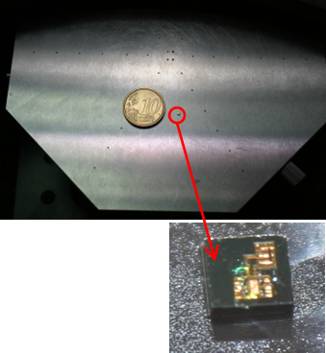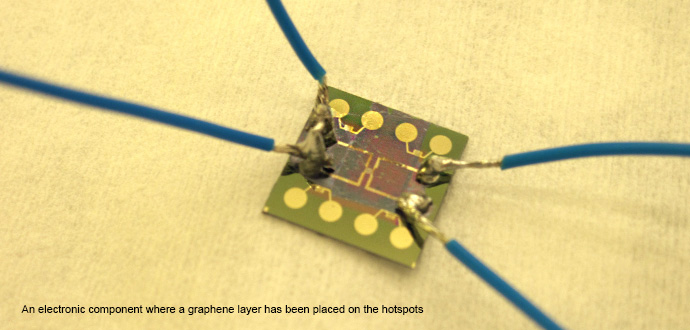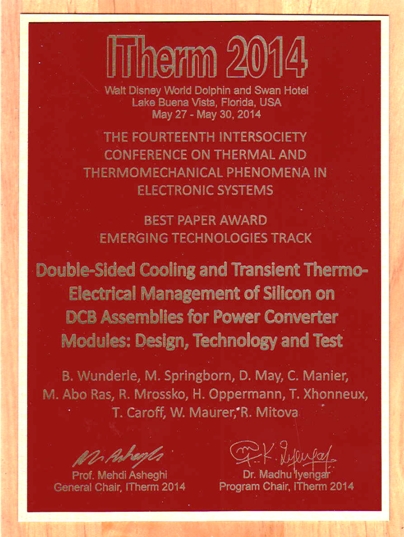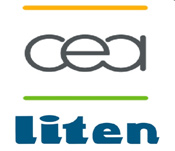Newsletters
Fourth e-newsletter
SMARTPOWER is an European large-scale integrating project aiming at developing the packaging and thermal management technologies required to achieve the efficient and cost-effective implementation of SiC- and GaN-based power modules respectively into industrial power inverters and RF transmitters systems.
As the project reached its end, the main materials and process developed in the project were implemented in high power demonstrators: Transmit device for RF GaN module and power inverter with SIC half-bridge low loss double side cooled power module.
To make the most of SiC and GaN core technologies (improved thermal performances and package sizing reduction), several thermal/energy management key technologies have been developed in the project and integrated into the power modules and RF demonstrators:
- Bulk and thin film thermoelectric coolers (TEC) process adapted to the Schneider electric demonstrator were finalized respectively by CEA and MicroPelt.
- Thermal interface materials were developed by SHT and TRT.
- High Performance heat spreading materials and CNT electrical interconnects were developed and characterized by Chalmers University
- Original single resonator GaN Temperature SAW sensor was developed by IMT and FORTH.
- A method was developed by BME to determine the temperature coefficient of the thermal resistance of die material.
Great efforts were spent on developing innovative packaging technologies:
- Development of new interconnect technologies for SiC integration in HT power modules (Transient Liquid Phase Soldering B, low temperature Ag Sintering)
- Multiple (up to 11) die embedding into cavities using wafer level processing on 200 mm wafer size
- Development of double sided cooling solutions using thermoelectric cooler and thermal buffer integration.
- Integrated temperature sensing module
- New reliability testing and thermal characterization of GaN and SiC modules
The demonstrators were built and tested. Live demonstration of the Schneider Electric’s set of two demonstrators was performed for the EC reviewers in Grenoble on the 23rd of October 2015.
Overall, the SMARTPOWER project reached all its objectives and was able to propose beyond the state-of the art technologies of high power applications
The project yielded over 40 publications in peer-reviewed journal and conference proceedings. At least two patents were filed with multiple ownership within the consortium. Commercial exploitation of new products and new characterization techniques developed in the frame of the SMARTPOWER project is planned.
Third e-newsletter
SMARTPOWER is an European large-scale integrating project aiming at developing the packaging and thermal management technologies required to achieve the efficient and cost-effective implementation of SiC- and GaN-based power modules respectively into industrial power inverters and RF transmitters systems.
In the past year the project partners have been focusing on the advancements of different technologies and on their implementation in relevant industrial demonstrators.
Status of the developed technologies for demonstrators
- Embedded Thermal sensors:
The first experiments regarding the proof of concept of a GaN SAW based temperature sensor monolithic integrated with a HEMT transistor has been performed. The functionality of the structure was qualitatively characterized on various substrates having different areas and properties (metallic, plastic, silicon).

- Double sided cooling:
A novel concept of integrating Silicon power dies along with thermo-electric coolers and a phase change heat buffer has been designed and tested in order to thermally manage transients occurring during operation. The concept features double-sided cooling as well as new materials and joining technologies to integrate the dies such as transient liquid phase bonding/soldering and sintering. Coupled-field simulations are used to predict thermal performance and are verified by especially designed test stands to very good agreement.
This work was presented and published in the proceedings of the 14th Itherm Conference in Orlando, USA, 2014. The author received a best paper award in the emerging technology track.
Second e-newsletter
SMARTPOWER is an European large-scale integrating project aiming at developing the packaging and thermal management technologies required to achieve the efficient and cost-effective implementation of SiC- and GaN-based power modules respectively into industrial power inverters and RF transmitters systems.
The phase of specification and first designs has ended and the project now focuses on the different technologies (in terms of performance and reliability) and on their implementation in relevant industrial demonstrators. Thus, we summarize below the main technologies developed and some selected progress.
Status of the main developed technologies and processes
- ThermoElectric modules : CEA focused on bulk TEC assembly for full package cooling. Thanks to better brazing process using screen printing and SAC, the contact resistance has been successfully decreased. TECs designed for the Schneider EasyPIM demonstrator were fabricated and tested at CEA and sent to NANOTEST for ZT measurement. In parallel, the new design for the production masks of the thin film coolers was finalized between Micropelt and the associated partners. Cooler devices were sent to TAIPRO for packaging.
- Thermal Interface Materials: A new carbon nano fiber metal based composite with relatively high thermal conductivity was developed. The thermal interface material presents a high thermal conductivity of 20 W/mK and low contact resistance of 0.94Kmm²/W. Also, a first proof of concept has been achieved for a self-standing film based on vertically aligned carbon nanotube and phase-change material.
- Electrical Interconnect: The densification and transfer process of CNT bump structures have been achieved. The electrical DC performance is well preserved after the series of process steps. In addition, the transfer yield of this technology on a relatively large substrate (9mm x 9mm) is quite promising, indicating stability and scalability of such a process.
- Heat spreading materials: The cooling effect of a graphene heat spreader has been demonstrated
Selected Progress in GaN SAW based temperature sensors
The partners IMT and FORTH have manufactured and characterized GaN SAW based temperature sensors. It was demonstrated that a single SAW resonator structure have better performances in terms of sensitivity than face to face resonator structures.
The sensor structure was optimized in order to obtain a high value of the quality factor, a high return loss at resonance and high temperature sensitivity. Using advanced nanolithographic processes we have obtained SAW based resonator structures having the room temperature resonance frequency of 5.4 GHz.
The SAW based temperature sensors structures were characterized in the -268°C - +150°C temperature range. The measured sensitivity in the 23-150°C temperature range, of the single resonator SAW temperature sensor was higher than 60 ppm/°C for on wafer measurements and about 50 ppm/°C for devices mounted in a ceramic test fixture. In literature, the reported value of TCF for GaN is 43 ppm/°C.
It was determined for the first time for GaN, the temperature where the temperature coefficient of frequency, TCF, (which represents the sensitivity expressed in ppm/°C) vanishes. This parameter is very important to define the temperature range where the SAW based resonator can be used as a temperature sensing element, or in an application where a stable behaviour of the resonance frequency vs. temperature is needed.
Press Release
Chalmers University issued a press release on the work regarding the cooling effect of graphene and published in the scientific publication Carbon.

For details on the press release please follow the link:
http://www.chalmers.se/en/news/Pages/Graphene-provides-efficient-electronics-cooling.aspx
Congratulations to both SMARTPOWER partners Chalmers and SHT Smart High Tech AB
First E-newsletter
SMARTPOWER is an European large-scale integrating project aiming at developing the packaging and thermal management technologies required to achieve the efficient and cost-effective implementation of SiC- and GaN-based power modules respectively into industrial power inverters and RF transmitters systems.
This main objective is supported in the project by two routes of research:
- The developments of key enabling technologies required to the integration of the power modules into viable systems: efficient and reliable thermal interface materials and electrical interconnect, highly efficient thermoelectric modules and integrated temperature sensor.
- The development of new 3D packaging techniques and the associated thermal architectures that will allow to integrate the core chips, together with the enabling technologies, in a viable and cost effective manner.
The project is completely organized in a top-down approach: all the activities are driven by the needs of the end-users, reflected in the specifications of the demonstrators.
In WP 1 Specifications and Design, product specifications and associated technologies specifications are produced to start the project. Then, all the technology and packaging developments are reported into system level simulations to continuously monitor the project progress toward the industrial project goals.
WP 2 is dedicated to the development of key enabling technologies. These key technologies are transverse and will the serve all the applications. They will enable the integration of the SiC and GaN chips into their specific packages with the required high power handling thanks to a leverage effect on specific packaging-related issues.
WP 3 is dedicated to integration and packaging aspects. The partners lead the development of new packaging solutions specifically adapted to the end-user needs. On one hand, the set of power inverters demonstrators need a packaging solution compliant with SiC technology and will integrate micro-Pelletier modules. On the other hand, a compact and reliable packaging solution will be developed for RF applications while being compliant with GaN power amplifier technology and the integration of a T° sensor. These tasks will be supported by stress measurement techniques.
WP 4 is dedicated to the fabrication of the RF module demonstrator (a 25W emitter using GaN High Power Amplifier) for aerospace applications. Performance and reliability evaluations will be carried out.
In WP 5, several demonstrators of industrial power inverters are undertaken, with objectives such as the development of a TE device for cooling during transient overloads in motor drive applications, a new low loss power module for the next generations of inverter products, using Silicon Carbide technologies or the development of multipurpose low loss power module for motor drive, UPS and solar inverter applications.
The project also includes a work package WP 6 devoted to dissemination and exploitation activities so as to ensure the dissemination of the project results toward the relevant industrial communities but overall to guarantee the industrial transfer of the developed technologies and to secure the corresponding supply chain.
Finally, management activities are grouped into WP 7 and drive all types of activities: technical, administrative, organizational, etc.
Selected Progress in Specifications & Design
The specifications of both RF transmitter and industrial power inverters demonstrators have been defined and allowed the definition of common targets for the whole project, at each level of work and for each objective: material and technologies, characterization, modeling and simulations and performance of the demonstrator.
The key enabling technologies specifications have also been addressed with the following objectives:
- ThermoElectric modules to address transient and hot-spot cooling in harsh environments
- Thermal Interface Materials with low thermal resistance and high reliability, crucial in the attaching process of the chips and in their thermal connection to the packages
- Electrical Interconnect to establish electrical contact through the packages
- Heat spreading materials to relax heat density
- T° sensors that are monolithically integrated as close as possible to the junction to monitor and control the operating temperature.
Guidelines for integrating thermal testability in the design phase have been issued. In particular, thermal transient testing was proposed as an essential method to characterize the thermal properties of semiconductor devices.
To ensure correct thermo-mechanical characterization of future ThermoElectric coolers, test stands have been conceived and designed for both modules and system levels. They will allow measurement of such parameters as coefficient of performance (CoP), Seebeck coefficient, temperatures and failure monitoring.
Contact: Dr. Afshin Ziaei, SMARTPOWER Coordinator.
Further information at www.project-smartpower.com









